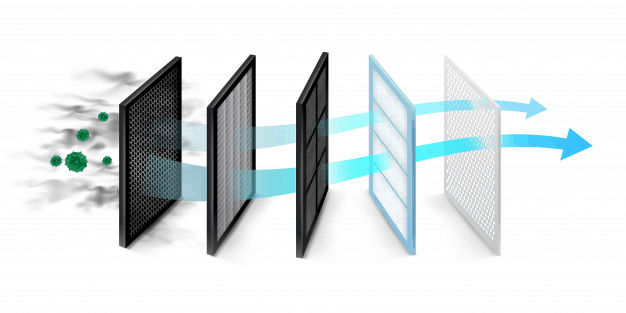The Best Energy Efficient Air Purifiers
So you’ve decided that you want to prioritize your health by cleaning that dirty air in your home or office - but you don’t want to rack up your...
Floor, wall and ceiling mounted to meet your unique project design.
According to the Environmental Protection Agency (EPA), you spend 90% of your time indoors - and indoor air quality is on average two to five times more polluted than outdoor air.
In some countries indoor air pollution is the leading cause of premature death, taking 1.6 million lives each year globally - while poor indoor air quality (IAQ) is not as harmful in the developed world, it does still present some serious health concerns that need to be addressed.
Here are some things you might not know about your office air quality and what you can do about it.
Inside office buildings, the HVAC system constantly recirculates the air to provide a “fresh” comfortable atmosphere. But how fresh is it really?
Your office’s HVAC takes outdoor air, pollution and all, and brings it inside where you and your coworkers spend most of your time.
Office air pollution can lead to many health problems from dizziness and shortness of breath to full-blown asthma attacks and pneumonia. As you might have guessed, employees suffering symptoms brought on by air quality issues will be much less productive at work.
Most of the air quality issues in your office are a result of your building’s HVAC system and how it circulates the air. There are two main factors that can affect the indoor air quality of your office building.
Particulate matter (or particle pollution) is small, inhalable particles between 10 and 2.5 micrometers in diameter that float through the air. To get a feel for how small that really is, a single human hair has a diameter of 70 micrometers.
Smoke, dust, and dirt make up larger particulate matter (PM10) that can get caught in your lungs and affect breathing, while smaller particulate matter particles (PM2.5) like chemicals from engine emissions are tiny enough to find their way into your bloodstream. Between the two, PM2.5 pollution poses the greatest risk to your health.
Your office’s HVAC system can take in both kinds of particulate matter and introduce it into your workspace, particularly if you work near a factory, busy highway, or any other source of pollution.
As people became more energy-conscious, engineers started to design buildings to be more airtight so HVACs could run more efficiently. While it might have helped with energy consumption, it also led to another phenomenon called “sick building syndrome.”
Sick building syndrome is when a building is too airtight and doesn’t allow fresh air to enter the space. The same stale, possibly contaminated air is constantly recirculated, which can cause a myriad symptoms in office workers, including:
If you’ve noticed any of these symptoms at work, indoor air quality might be to blame. Naturally, employees suffering from sick building syndrome tend to be more irritable and distracted from their work, resulting in a lack of productivity - not to mention they could be at risk for potentially serious health problems.
| Interested in learning more on air quality? Check out these blogs: |
Outdoor pollutants come from a wide range of sources.
Things like construction projects, unpaved roads, vehicle emissions, and smokestacks all release particulate matter into the air, which can be taken in by your HVAC and distributed throughout the office. Worse yet, these aren’t the only culprits.
Indoor air pollution can come from any number of sources inside your office:
All these sources can release toxins into the air, which are then recirculated throughout the day.
Even a building occupant can be a source of office air quality issues. If a building is too airtight, everyone breathing can cause CO2 levels to rise, which can lead to shortness of breath and dizziness.
With so many sources of pollution and the harmful effects of poor office air quality, it’s important to take the initiative and improve your workplace. If you’ve noticed any of the symptoms of poor air quality, here are some ways you can promote air flow to increase productivity, happiness, and health:
Of course, all of these solutions only treat the symptoms, not the underlying cause of poor air quality: your HVAC system. If you’re interested in getting to the root of the problem, an underfloor air distribution (UFAD) system might be the answer.
Most HVAC systems are designed to mix the air in a room to maintain a consistent temperature. Ducts are used to introduce and remove conditioned air from the space, which means that dirty air is continuously recirculated, leading to “sick building syndrome.”
UFAD systems are a cost-effective solution to traditional overhead HVAC systems. Instead of releasing conditioned air from the ceiling, it’s released from the floor through various outlets strategically installed throughout the workspace.
Warm air is then returned to the system from the ceiling - which makes sense because warm air rises - and never mixes with the fresh conditioned air. This helps to improve indoor air quality by removing more pollutants, making your office environment a safer and more productive place to work.
In addition to increasing the overall air quality, UFADs also use smaller fans which means reduced noise for better employee focus, a longer lifespan for your system, and long term energy savings.
If you’re interested in learning more about improving the air quality of your office or about underfloor air distribution, ask the experts at AirFixture. We can help you lower your long-term heating and air conditioning costs and improve the health of everyone working in your office. Contact us to see how a UFAD system can improve your indoor environment today.

So you’ve decided that you want to prioritize your health by cleaning that dirty air in your home or office - but you don’t want to rack up your...

Between work, home, and going out, the average American spends about 90% of their time inside.

As people seek any means to protect themselves and their families from the spread of Covid-19, many are asking, “Do air purifiers kill viruses” like...